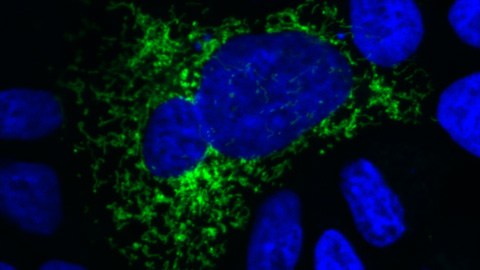Two groups of neurons identified in causing Leigh Syndrome

17/09/2019
Leigh Syndrome affects one in every 40,000 newborns, and is produced by deficits in the mitochondria, which are in charge of providing the energy needed for cells to function correctly. Thus, cells with a high energy demand such as the brain and muscles are most affected. Recently, the Mitochondrial Neuropathology laboratory at the UAB Institute of Neuroscience, directed by Albert Quintana, published an article in eLife describing the neurons responsible for the different affectations produced by this disorder. The generation of two new mice models with this disease has allowed researchers to understand better the causes and opens the door to new studies which could find a treatment.
In order to establish which neurons were responsible for the different disease symptoms, researchers “deactivated" the Ndufs4 gene, a key piece of the mitochondria in three types of neurons: the glutamatergic neurons, which activate other cells; the GABAergic neurons, which inhibit other cells; and the cholinergic neurons, which carry information from the brain to the organs). The mice with modified cholinergic neurons did not present any manifestation of the disease, whereas the others did: in both cases, the mice had very low body weight and died prematurely. Therefore, this is the first time that evidence has been found that the neurons releasing glutamat and GABA are related to Leigh Syndrome, whereas this is not the case of the cholinergic neurons.
Notable differences were also observed in the two neuron types related to the disorder. The mice with affectations in the activator neurons showed severe problems with breathing and movement, functions related to the brainstem where this type of neuron is located. Those with affectations in inhibitor neurons however presented severe cases of epilepsy, given that the function of these neurons is to prevent brain activities which can lead to this disorder, as well as premature death.
These discoveries were tested at different levels and with the use of various techniques, and therefore represent a very important step in the direction of finding and developing a treatment.
“One of the greatest unanswered questions about mitochondrial disease is being able to identify why only some neurons are affected by this mutation and what role they play in the development of the disease. In this study we were able to develop new models for Leigh Syndrome, which have helped us name the neurons and clarify their involvement in the disease", explains Albert Quintana.
To date, a cure has not been found for this disease and in the majority of cases, patients die prematurely. With studies like this, researchers can begin to search for specific treatments depending on the type of neuron each patient is affected by.
The research, directed by Albert Quintana, professor of the UAB Department of Biochemistry and Molecular Biology and researcher at the UAB Institute of Neuroscience (INc); and Irene Bolea, first author and researcher at the INc, included the collaboration of researchers from the Seattle Children’s Research Institute, the Network Center for Biomedical Research in Neurodegenerative Diseases (CIBERNED) and the University of Washington.
Original article:
Bolea I, Gella A, Sanz E, Prada-Dacasa P, Menardy F, Bard, AM, Machuca-Márquez P, Eraso-Pichot A, Mòdol-Caballera G, Navarro X, Kalume F, Quintana A. Defined neuronal populations drive fatal phenotype in a mouse model of Leigh Syndrome. eLife. 2019; 8:e47163DOI: 10.7554/eLife.47163